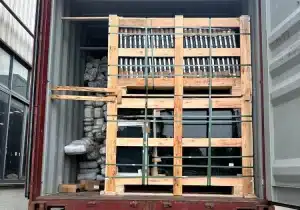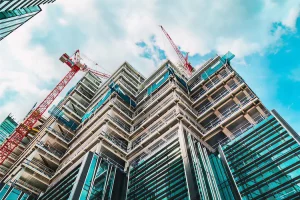1. Limit State Design Method and Reliability Control
To build a solid foundation, this section covers seven key areas:
① an overview of limit state design, ② classification of design situations, ③ detailed limit state types, ④ load effects,⑤ environmental impacts, ⑥ calculation requirements, and ⑦ reliability and safety levels.
1.1 Overview of Limit State Design
The limit state of a curtain wall support structure refers to a condition where the structure exceeds a specific threshold and can no longer fulfill the prescribed functional requirements. This limit state design is to ensure the structure does not surpass these critical states. The main limit states for curtain wall support structures include the ultimate limit state, serviceability limit state and durability limit state, which will be detailed in Section 1.3.
Based on probability theory, the limit state design method employs partial safety factor expressions for calculations. And the designs are carried out respectively for the ultimate, serviceability, and durability limit states.
1.2 Classification of Design Situations
During its service life, a curtain wall support structure is subjected to the following different 4 design situations.
1.2.1 Persistent Design Situation
As the name suggests, it exists continuously when the structure is in use, and the duration is long. It is of the same order of magnitude as the design service life, and is applicable to normal use.
1.2.2 Transient Design Situation
This transient situation occurs during construction or maintenance, with a short duration and a high probability of occurrence.
1.2.3 Accidental design situation
This situation includes abnormal conditions like impact, explosion and fire, which have a low probability of occurrence and a short duration.
1.2.4 Seismic design situation
This is a design condition when the structure is subjected to an earthquake.
1.3 Detailed Classification of Limit States
1.3.1 Ultimate Limit State (Load-Bearing Capacity)
The ultimate limit state corresponds to the structure or components reaching their maximum load-bearing capacity or undergoing deformations that make continued support unsuitable. See the following examples:
- Failure of components due to stresses exceeding material strength
- Loss of structural stability
- Fatigue failure of components
1.3.2 Serviceability Limit State (Normal Use)
The serviceability limit state occurs when the structure or components reach prescribed limit values that affect normal use or appearance, such as excessive glass deformation. Serviceability limit states are divided into these two categories.
◆ Irreversible state: In this state, consequences cannot be restored after the overload is removed.
◆ Reversible state: Unlike the above state, consequences still can be restored after the overload is removed.
1.3.3 Durability Limit State
The durability limit state occurs when material performance deteriorates to limit values due to environmental effects, such as failure of anti-corrosion coatings, aging of sealants, or notching of glass ribs.

1.4 Design Calculations and Load Effects
Design analysis and calculations must be carried out for different limit states, with the persistent design situation generally governing the ultimate limit state (load-bearing capacity) and serviceability limit state (normal use).
Load effects include internal forces in components (tension, compression, shear, bending moment, torsion) as well as deformations and cracks. Structural resistance refers to the capacity of the structure to withstand these load effects and environmental influences.
1.5 Classification of Environmental Effects and Design Requirements
Environmental effects are categorized as permanent, variable, and accidental, encompassing mechanical, physical, chemical, and biological factors. These effects may degrade material properties and impact structure’s safety and usability.
Designs should quantitatively describe environmental influences and adopt corresponding measures based on the material’s corrosion resistance rating.
1.6 Design Situations and Calculation Requirements
Design Situation | Ultimate Limit State (Load-Bearing) | Serviceability Limit State | Durability Limit State |
Persistent | Use basic combination | Required | Recommended |
Transient | Use basic combination | Optional | Not required |
Accidental | Use accidental combination | Not required | Not required |
Seismic | Use seismic combination | Optional | Not required |
In all cases, the design should be based on the most unfavorable load effects, and the structural resistance must be greater than or equal to the applied load effects (Resistance ≥ Load Effect).
1.7 Reliability and Safety Levels
The reliability of the curtain wall support structure refers to the probability that the structure will complete its intended function within the specified time and conditions. The design should ensure that the safety, applicability and durability requirements are met within its service life.
The reliability level is determined based on the safety class and failure mode. Different functions may require different reliability levels, typically measured by a reliability index. The reliability index serves as the basis for partial factor design. For each decrease in safety class, the reliability index typically decreases by 0.5.
- For ultimate limit states under persistent design situations, the reliability index is generally set at 3.2 for ductile failure modes, assuming a safety class of Level II.
- For serviceability limit states, the reliability index is selected between 0 and 1.5, depending on whether the load effect is reversible.
- For durability limit states, the reliability index ranges from 1.0 to 2.0, also depending on reversibility.
A solid understanding of limit state design methods and their associated reliability levels forms the foundation for safe curtain wall structural design.
Accordingly, the design process must include detailed load calculations, rational selection of design loads, and accurate analysis of structural response to ensure stability and durability of the curtain wall system under actual service conditions.

Next, we will continue with Part Two to conduct load analysis and explore structural design implementation.
2. Load Analysis and Structural Design Implementation
In this section, we take a closer look at the load analysis and practical structural design considerations that guide the real-world application of curtain wall support systems. The discussion is organized across five core areas:
① wind load, ② seismic and thermal effects, ③ load combinations, ④ selection of strength design values, and ⑤ deflection control strategies.
2.1 Wind Load Calculation
Wind loads on curtain wall support structures should be determined in accordance with the Load Code for the Design of Building Structures or validated by wind tunnel test results. In typhoon-prone regions, it is essential to further consider the effects of local shape coefficients and internal pressure coefficients during the construction phase, and to perform refined calculations accordingly.
2.2 Seismic Effects and Temperature Variations
According to the Code for Seismic Design of Buildings (GB 50011-2010), curtain wall components must account for horizontal seismic forces induced by self-weight, as well as additional effects caused by relative displacement at supports. The equivalent lateral force method is typically used for analysis.
Thermal expansion and contraction due to temperature fluctuations must be addressed through structural detailing, such as providing expansion gaps, to prevent damage from thermal stress. Article 3.7 of the seismic code also specifies the requirements for evaluating curtain wall connections, seismic performance, and potential adverse impacts on the primary structure.
In load-bearing capacity calculations, when gravity loads act unfavorably on components, the partial safety factors γG and γW should be taken as 1.3 and 1.5 respectively. When favorable, they are taken as 1.0 and 1.5.
2.3 Load Combination and Analysis Methods
Structural design must consider the most unfavorable combinations of various actions—including wind, seismic forces, gravity, and temperature effects—especially for critical areas such as building corners, façade discontinuities, and connection nodes.
Load effect analysis methods include analytical methods, approximate methods, and finite element methods. For structures with significant geometric nonlinearity (e.g., trusses or long-span systems), stability and nonlinear effects must be taken into account. The computational model should clearly define boundary conditions, section properties, material parameters, and loading schemes.
Connections between the curtain wall and the main structure must ensure reliable load transfer while allowing for relative displacement. When necessary, an integrated analysis with the primary structure should be conducted to verify collaborative performance.
2.4 Basis for Selecting Strength Design Values
The strength design values for various types of curtain wall structures should be selected based on the material type and corresponding applicable standards. Commonly referenced codes include:
- Technical Code for Glass Curtain Wall Engineering (JGJ 102-2003)
- Code for Design of Aluminum Alloy Structures (GB 50429)
- Standard for Design of Steel Structures (GB 50017-2017)
- Technical Code for Cold-Formed Thin-Walled Steel Structures (GB 50018)
- Technical Code for Metal and Stone Curtain Wall Engineering (JGJ 133)
- Technical Code for Man-made Panel Curtain Wall Engineering (JGJ 336)
2.5 Deflection Control and Limitation Requirements
Deflection limits are critical indicators for ensuring both the safety and visual performance of curtain wall systems. The design must comply with the following standards:
- Technical Code for Glass Curtain Wall Engineering (JGJ 102)
- Technical Specification for Application of Building Glass (JGJ 113)
- Technical Code for Metal and Stone Curtain Wall Engineering (JGJ 133)
- Technical Code for Man-made Panel Curtain Wall Engineering (JGJ 336)
3. Conclusion
In conclusion, the design of curtain wall supporting structures must be based on the theory of limit state design, in accordance with the reliability indices and design requirements specified in relevant codes. It is essential to determine the magnitude and combination of various loads scientifically, and to carry out structural analysis and detailing rationally. Through comprehensive design and analysis methods, the curtain wall system can be ensured to possess adequate safety, serviceability, and durability under complex and changing environmental conditions, thereby providing strong support for the overall performance of the building.





